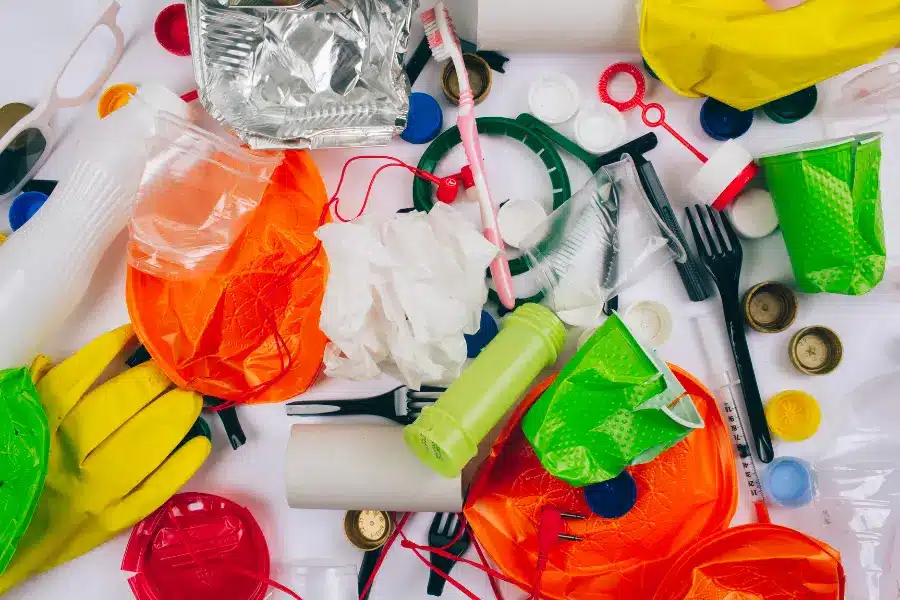Single-use plastics are items made from fossil fuel-based chemicals that are designed to be used once, then discarded after use.
How single-use plastics revolutionized the packaging industry
The advent of plastic allowed for a proliferation of inexpensive packaging replacing that made from natural materials (paper and glass). Plastic was sanitary, durable, water-resistant, and could be molded into any shape. Examples of single-use plastics in packaging include bottles, takeaway containers, and plastic bags. The invention of shrinkwrap meant that multiple items could be packaged together, no matter how bulky or large.
How single-use plastics revolutionized the food industry
The use of plastic in food packaging meant that food could be stored for longer, prepared in advance, and was available instantly in the form of microwaveable ready meals. Food could also be packaged in much smaller quantities. Single-use plastic was used for a wide range of items such as margarine tubs, condiment bottles, fruit and veg trays, crisp packets, spices, and disposable cutlery. It was also widely used in takeaway containers. There was a widely held belief that plastic shrinkwrap was good for the environment as it dramatically reduced food waste (for example preserving the shelf-life of cucumbers).
Single-use plastics are bad for the environment
Creating plastic packaging emits huge amounts of greenhouse gases due to the extraction and transportation of fossil fuels (natural fuels such as coal and gas). The production of plastic is responsible for 5% of greenhouse gas emissions alone, a significant contributor to climate change. Of all the plastic produced, nearly half is single-use plastic.
Single-use plastic waste is even more detrimental to the environment
The introduction of single-use plastics led to a throwaway society. About five trillion plastic bags are produced globally each year; depressingly it can take a single bag up to 1000 years to completely disintegrate. At least 14 million tons of plastic end up in the ocean every year, causing the death of aquatic wildlife and birds, either from suffocation or ingestion. Plastics that end up in landfill break down into microplastics (particles less than 5 mm wide) which end up in the food chain as well as airborne.
These particles are so small it’s impossible to quantify, but there is evidence to show they could be a problem. Microplastics can lead to starvation in wildlife, potentially damage human DNA and cause inflammation; worryingly, the full impact of microplastics on human health is not yet known. Incineration of plastic waste generates toxic gases that contribute to climate change and air pollution linked with respiratory illnesses.
How the use of single-use plastics has changed
Increased environmental awareness by businesses and consumers has driven a reduction in the creation and use of single-use plastics. Plastic straws are now banned in many places, coffee shops reward customers for using reusable coffee cups and plastic packaging tends to note the proportion of recycled plastic that has been used in its creation. Although there is a drive towards reducing and recycling, many countries do not have sufficient infrastructure in place to collect, sort, and recycle plastic packaging waste.
Sustainable alternatives to single-use plastic packaging

Environmentally friendly packaging is created from renewable resources and can be recycled or reused. For example, sugarcane shrinkwrap films can comprise up to 51% sugarcane cellulose and are both durable and safe for use with food. There is also corn starch packaging for peanuts that is fully dissolvable in water. Many shops now offer a refillable service for water or food such as nuts and raisins allowing containers to be reused. Packaging innovations will continue to evolve as we try to move towards a plastic-free future with packaging solutions that are both convenient for consumers and don’t negatively impact the environment.



![10 Best Bags for Nurses | Personal Recommendation [2023] 5 Best Bags For Nurses Reviews in 2021](https://knowworldnow.com/wp-content/uploads/2022/12/Best-Bags-For-Nurses-Reviews-in-2021.webp)



![F95Zone Games - The Ultimate Guide for 2021 [F95Z Guide] 9 F95Zone Games](https://knowworldnow.com/wp-content/uploads/2021/07/ArTtW5LrK3b-z-0-y-637f48d86203817a9042a857.webp)